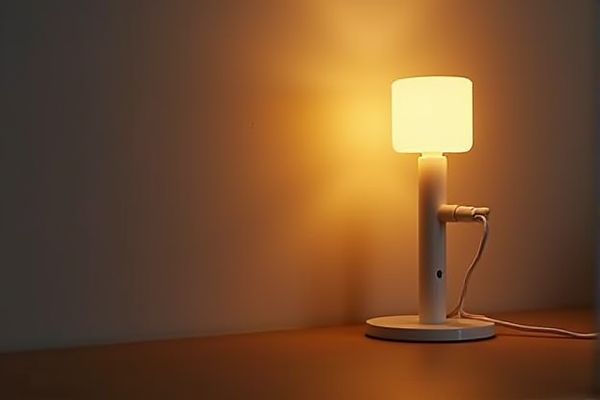
Cordless lamps offer the convenience of portability and flexible placement without the restriction of cords, making them ideal for spaces where mobility is key or power outlets are scarce. Your choice between cordless and plug-in lamps depends on your lighting needs and setup, so explore the rest of the article to find which option suits your lifestyle best.
Table of Comparison
| Feature | Cordless Lamp | Plug-in Lamp |
|---|---|---|
| Power Source | Rechargeable battery | Direct electrical outlet |
| Portability | Highly portable; no wires | Limited by cord length |
| Usage Duration | Depends on battery life (4-12 hours) | Unlimited when plugged in |
| Brightness | Variable; often adjustable | Consistent; depends on bulb wattage |
| Installation | No installation needed | Requires electrical outlet |
| Cost | Typically higher upfront cost | Generally lower upfront cost |
| Maintenance | Battery replacement or charging required | Minimal; bulb replacement only |
Introduction to Cordless and Plug-in Lamps
Cordless lamps operate on rechargeable batteries, offering enhanced portability and flexibility for indoor and outdoor use without the need for a nearby power outlet. Plug-in lamps require continuous access to electrical sockets, providing consistent power for extended lighting without battery limitations. Understanding the differences in power source and mobility helps determine the ideal lighting solution for various environments and tasks.
Key Differences Between Cordless and Plug-in Lamps
Cordless lamps operate on rechargeable batteries, providing portability and flexibility without the need for a power outlet, making them ideal for outdoor or temporary lighting situations. Plug-in lamps rely on a constant electrical connection, offering consistent power and brightness suitable for long-term indoor use with minimal maintenance. Battery life, convenience, and usage environment are the critical factors distinguishing cordless lamps from plug-in lamps.
Design and Aesthetics: Cordless vs Plug-in
Cordless lamps offer sleek, modern designs with minimal visible components, enhancing aesthetic appeal and flexibility in placement without the need for a power outlet. Plug-in lamps often feature traditional designs with cords that may limit placement options and clutter visual space. The cordless variety caters to contemporary interiors prioritizing clean lines and mobility, while plug-in lamps suit settings where constant power access and classic styles are preferred.
Portability and Placement Flexibility
Cordless lamps offer superior portability and placement flexibility due to their battery-powered design, enabling use in any location without needing a nearby power outlet. Plug-in lamps require constant access to electrical sockets, limiting their placement options and tethering them to specific areas within a room. The cordless feature supports versatile lighting solutions for outdoor settings, travel, or rooms with limited electrical access, enhancing convenience and usability.
Power Source and Energy Efficiency
Cordless lamps rely on rechargeable batteries, providing portability and flexibility without the need for a constant power outlet, making them ideal for spaces with limited access to electricity. Plug-in lamps draw power directly from an electrical socket, typically offering consistent brightness and continuous operation without concerns about battery life. Choosing cordless lamps enhances energy efficiency by utilizing rechargeable power and reducing electricity consumption when used strategically in your home.
Performance and Light Quality Comparison
Cordless lamps offer portability and flexibility but often have lower brightness and shorter runtime compared to plug-in lamps, which provide consistent, high-intensity illumination due to direct power supply. Plug-in lamps typically deliver superior light quality with stable color temperature and minimal flicker, enhancing visual comfort for tasks requiring precise lighting. When choosing your lighting solution, consider whether performance consistency or mobility better suits your environment and usage needs.
Installation and Maintenance Requirements
Cordless lamps offer hassle-free installation with no wiring needed, making them ideal for versatile placement and easy relocation. Plug-in lamps require access to power outlets and occasional cable management, which can limit positioning flexibility. Maintenance for cordless lamps often involves regular battery charging or replacement, whereas plug-in lamps depend primarily on bulb replacement and minimal electrical upkeep.
Cost Considerations: Initial and Long-term
Cordless lamps typically have a higher initial cost due to built-in batteries and rechargeable technology, while plug-in lamps are generally more affordable upfront. Over time, cordless lamps may incur additional expenses for battery replacements and charging, whereas plug-in lamps maintain lower operating costs by relying on direct electricity. Your choice should balance upfront investment with long-term energy and maintenance costs to determine the most cost-effective lighting solution.
Best Use Cases for Cordless and Plug-in Lamps
Cordless lamps excel in portability and flexibility, making them ideal for outdoor settings, temporary lighting, or areas without easy access to power outlets. Plug-in lamps provide consistent power and are best suited for permanent indoor use, such as desk lighting or bedside reading where continuous illumination is needed. Your choice depends on whether you prioritize mobility or uninterrupted lighting performance.
Conclusion: Choosing the Right Lamp for Your Needs
Cordless lamps provide portability and flexibility, ideal for spaces without nearby outlets or for outdoor use, while plug-in lamps offer consistent power and greater brightness suitable for stationary lighting in homes or offices. Assess your lighting needs, battery life preferences, and usage environment to determine which type best enhances convenience and functionality. Prioritizing these factors ensures optimal illumination tailored to your lifestyle.
 homyna.com
homyna.com